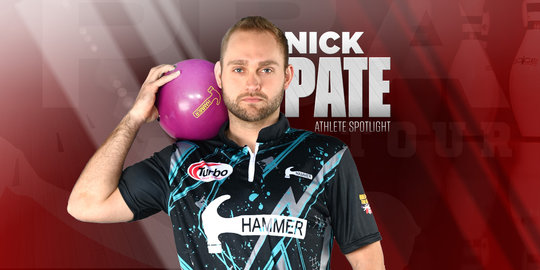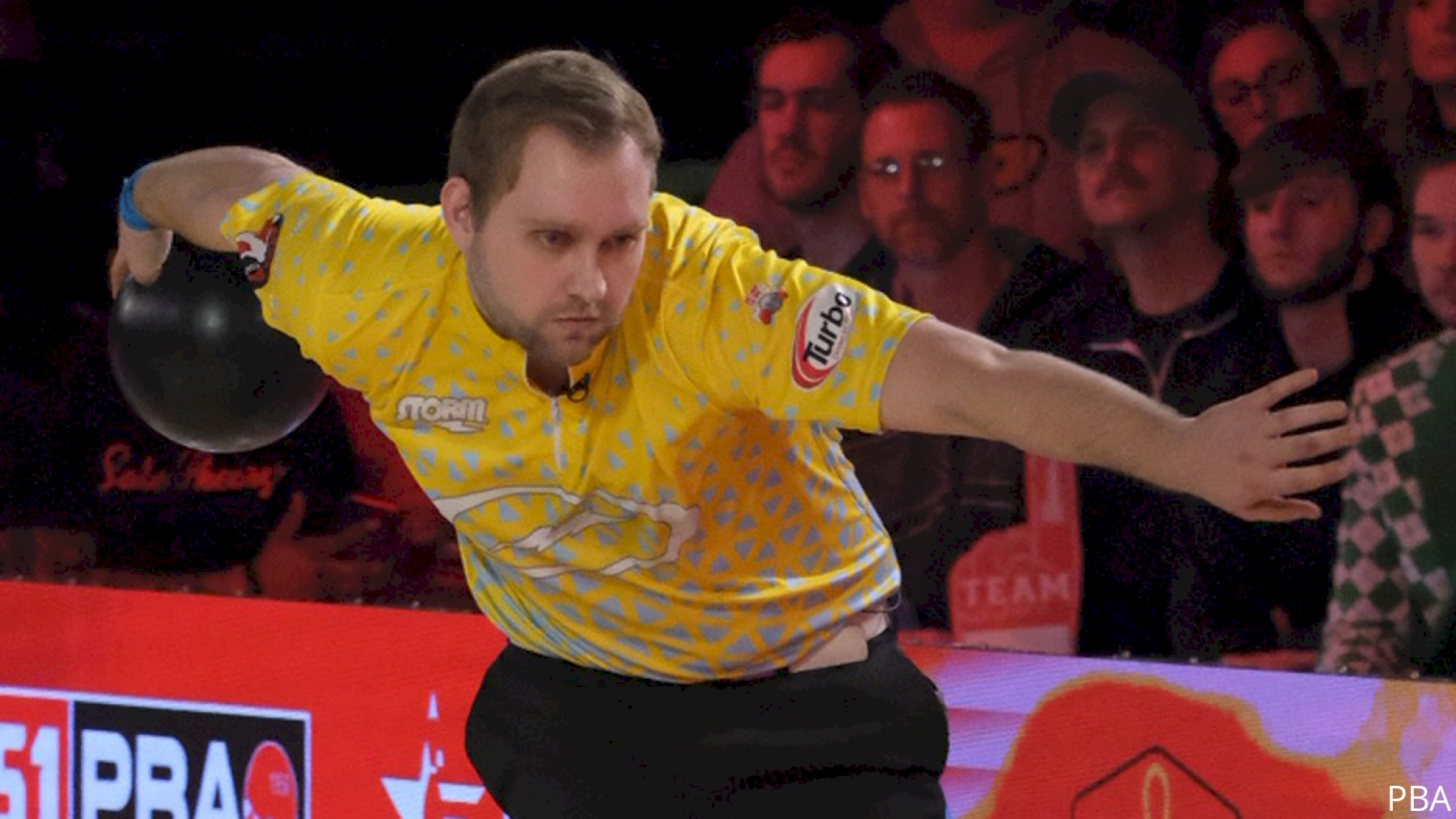
Patience and Aggression Key to Nick Pate's Next Evolution
If you were to dream of winning your first PBA Tour title, you would probably imagine something like this:
You average almost 222 to earn the No. 3 seed for the stepladder. In the opening match, you draw Anthony Simonsen, who won the U.S. Open about 10 days earlier. But you're not intimidated, you've been waiting for this opportunity your entire life. You take care of Simo 237-226.
Your reward for taking down the 25-year-old superstar? EJ Tackett, you know, the guy who just led the U.S. Open by over 500 pins. No problem there, either. 237's a winner once again.
Now, you’re in the finals. Your first ever national tour title sits just 10 frames away. You can see the trophy sitting on that little table a few feet from your chair.
But first, you must defeat the one man who stands in between you and destiny: Jason Belmonte, the winningest player of the modern era. To be the best, you have to beat the best. Bring it on.
It’s a back-and-forth, high-scoring affair. Belmo fires the front-six, but you throw the front-seven! Then transition hits and you miss the move. After an open frame in the 8th and a spare in the 9th, Belmonte can shut you out with a double. You need some help.
The Australian delivers the first strike, because of course he does. The second one looks good, too, but the 6-pin wraps around the 10. Wait, no! Here comes the messenger… just in front of the 10. There’s your opening.
You’re now two strikes away from your first ever PBA title. (You’ll also need eight pins on the fill, but you can get that with your eyes closed. Just ask Dom Barrett.) This is the moment you've always dreamed of.
The first shot is good, really good, probably the best you’ve ever thrown in your life. You sent all 10 pins straight back like Jadeveon Clowney dismantled that poor Michigan running back. One strike away now.
The second shot doesn't look much different, maybe a tad right, but it’s pretty good. Good enough to strike, for sure, or so you thought. The 10-pin decided it wasn’t good enough. 249-243, Belmo. Second place will have to do. Maybe next time.
If I was going to win my title, that would have been the one to remember for a long time — Nick Pate
As you may have surmised, that anecdote was reality for Nick Pate. As the 27-year-old Minnesotan enters his sixth season on the national tour, the 2022 PBA David Small’s Kokomo Open is the closest he's come to the PBA mountaintop.
When he reflects on that tournament, coming fractions of an inch away from securing the elusive victory, he doesn’t dwell on the 10-pin leave.
“I actually took it as positive right away,” he said. “I talked to my girlfriend probably an hour after that show, and I was just smiling.
“The fact that I was able to throw one for the title,” he added, “I’m grateful to have been in that situation and to put the ball where it needed to be. You hope you can be in that position and hope one day that it will fall.”
Seven months removed from that tournament, the 10th frame isn’t the one that comes to Pate’s mind. It's the 7th frame, where he said Belmonte left a 4-pin off a pretty good shot. In hindsight, Pate said he should have moved before his next shot on that lane. If he does, he probably gets a mark instead of an open and then doesn't need to double in the 10th.
Pate said he doesn't tend to think about the 10-pin. Instead, he focuses on positive takeaways: making the show, defeating Simonsen and Tackett, leading in the title match. I made a mistake against Belmonte, and I still had a chance to win.
“It was definitely one of those experiences that [makes you think] I do belong out here. I can strike with the best,” he said.

Nick Pate made his TV debut at the 2020 Go Bowling! PBA Indianapolis Open, finishing third.
While Pate grew up in a bowling family — furiously working to prove his superiority over his siblings, Lauren and Josh — he didn’t blossom until he arrived at Midland University in 2013. He made the varsity team as a freshman and began working with senior Perry Crowell, who helped transform his game. He said Crowell, who made the 2020 U.S. Open show, still helps him to this day.
As a sophomore, Pate was named a First Team All-American alongside Michael and Darren Tang, Nick Kruml and François Lavoie. Graham Fach and AJ Johnson made the Second Team. He led Midland to the Intercollegiate Team Championships, earning MVP honors despite their loss to Wichita State.
(To further emphasize the collegiate talent boom during the mid-2010s, the Shockers started Mitch Hupé, Matt McNiel, AJ Chapman and Lavoie. What a time to be alive.)
In 2017, Pate announced himself as a force. He kicked off the year with a seventh place finish at Team USA Trials, earning his first career berth on the national team. Four months later, he captured the Intercollegiate Singles Championship title. He also earned his second First Team All-American honor and was named the season's MVP.
Since college Pate has shined as a member of Team USA. Over the past four years, he has tallied five gold and two silver medals in international competition and rolled a pair of 300 games in 2019.
On the PBA Tour, he has shown steady improvement while fighting the steep learning curve. His growth hasn't followed the linear trajectory that it did in college, but that's life. With only so many titles to go around and a handful of generational talents making it all the more challenging to pry one away, he said he has learned to have a patient, yet aggressive mindset.
In 2022, the right-hander took second place in Kokomo, third at the PBA David Small's Best of the Best Championship — where he averaged over 246 across 20 games of qualifying to earn the No. 2 seed — and sixth at the PBA Colorado Springs Open. Pate said he wouldn’t call his 2022 season a breakout, but he took a clear step in the right direction.
“It’s one of those seasons that gets me excited for the next one,” Pate said. “I want to build off of that. There's definitely room for improvement.”
Pate’s best performances last season all occurred in Storm Cup events. He said the shorter blocks and frequent re-oils played to his strengths.
“I definitely like to bowl on the fresh,” he said. “I like to use surface, throw it a little bit harder and keep my angles in front of me. I can still bowl on the burn and get around it, but I feel like I strike a little bit more in games 1-2-3.”
He finished the season 21st in points, about 2,000 points shy of making the Kia PBA Playoffs. You can find those points anywhere, most obviously in that match against Belmonte; if the 10-pin carries, Pate’s in.
“That's the ultimate goal when you bowl the tour season because it rewards a full season's worth of good bowling,” he said. “To miss by few thousand points the last few years, it really hurts. I made it in 2020 when (the field) was 24, but I want to get back there.”
From the glass half-full perspective, Pate finished 21st without doing much of anything in the majors. He totaled 1,425 points in majors, 855 of which came via a 25th place finish at the World Championship. He did not qualify for the Tournament of Champions and missed the U.S. Open for a wedding.
Overall, just 14.8% of Pate’s total points came from majors. Compare that to Bill O’Neill, who earned the 16th and final spot in the playoffs: O’Neill racked up almost 6,000 points in majors, comprising 51.5% of his total points.
The solution seems so simple. Just bowl better at majors! But it doesn’t take an expert to know that’s easier said than done. Majors are longer, the patterns are harder (usually) and the competition is stronger.
Pate has all the tools to take the next step — well, except for lofting beyond the arrows, but he's working on that — and dedicates himself to consistent strength and conditioning training. That allows him to stay sharp during a grueling tour season where players often bowl multiple blocks of six-eight games per day.
He recalled one instance during the second block of a two-a-day back in March: “Belmo came up to me in Lubbock and he's like, ‘Man, I'm tired.’ I said ‘Really? I could go another eight more.’
Belmonte, despite battling fatigue, went on to win that tournament. It's a perfect example of how the mental game matters as much, if not more, than the physical game at this level.
"I can train myself to outlast the field physically, but I’m training to outlast them mentally, too," Pate said.
Since Team USA camp last month, Pate has been utilizing a new mental performance program. He said the team has worked with Brian Cain, the author of the program, in the past but it clicked this time. He saw immediate results, winning his first tournament and adding a handful of top-five finishes.
“You can be as sharp as you want physically, but ultimately it comes down to having that elite mindset, controlling what you can control and not letting outside distractions interfere,” he said. “I can't wait to try it out on tour. It's going to work.”
Pate has a lengthy checklist for 2023: winning his first title, returning to Team USA, defending his medals at the Pan American Games and making the playoffs. It’s a long list, but he said it's attainable if he puts the work in.
In 2017, he made the leap from solid college player to undeniable force and has remained one of the country’s top players for more than half a decade. It feels like only a matter of time before he elevates at the pro level.
"If you want something, you have to go out and work hard for it," he said. "This is my sixth year on tour. I'm hungry to win, but I'm going to stay patient. I'm going to put all my all my effort into getting that first title.”
